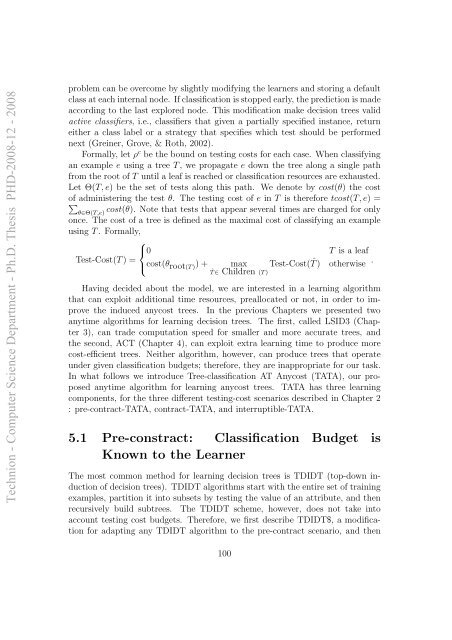anytime algorithms for learning anytime classifiers saher ... - Technion
anytime algorithms for learning anytime classifiers saher ... - Technion
anytime algorithms for learning anytime classifiers saher ... - Technion
You also want an ePaper? Increase the reach of your titles
YUMPU automatically turns print PDFs into web optimized ePapers that Google loves.
<strong>Technion</strong> - Computer Science Department - Ph.D. Thesis PHD-2008-12 - 2008<br />
problem can be overcome by slightly modifying the learners and storing a default<br />
class at each internal node. If classification is stopped early, the prediction is made<br />
according to the last explored node. This modification make decision trees valid<br />
active <strong>classifiers</strong>, i.e., <strong>classifiers</strong> that given a partially specified instance, return<br />
either a class label or a strategy that specifies which test should be per<strong>for</strong>med<br />
next (Greiner, Grove, & Roth, 2002).<br />
Formally, let ρc be the bound on testing costs <strong>for</strong> each case. When classifying<br />
an example e using a tree T, we propagate e down the tree along a single path<br />
from the root of T until a leaf is reached or classification resources are exhausted.<br />
Let Θ(T, e) be the set of tests along this path. We denote by cost(θ) the cost<br />
�<br />
of administering the test θ. The testing cost of e in T is there<strong>for</strong>e tcost(T, e) =<br />
θ∈Θ(T,e) cost(θ). Note that tests that appear several times are charged <strong>for</strong> only<br />
once. The cost of a tree is defined as the maximal cost of classifying an example<br />
using T. Formally,<br />
⎧<br />
⎨0<br />
T is a leaf<br />
Test-Cost(T) =<br />
⎩cost(θroot(T)<br />
) + max Test-Cost( ˆ T) otherwise .<br />
ˆT ∈ Children (T)<br />
Having decided about the model, we are interested in a <strong>learning</strong> algorithm<br />
that can exploit additional time resources, preallocated or not, in order to improve<br />
the induced anycost trees. In the previous Chapters we presented two<br />
<strong>anytime</strong> <strong>algorithms</strong> <strong>for</strong> <strong>learning</strong> decision trees. The first, called LSID3 (Chapter<br />
3), can trade computation speed <strong>for</strong> smaller and more accurate trees, and<br />
the second, ACT (Chapter 4), can exploit extra <strong>learning</strong> time to produce more<br />
cost-efficient trees. Neither algorithm, however, can produce trees that operate<br />
under given classification budgets; there<strong>for</strong>e, they are inappropriate <strong>for</strong> our task.<br />
In what follows we introduce Tree-classification AT Anycost (TATA), our proposed<br />
<strong>anytime</strong> algorithm <strong>for</strong> <strong>learning</strong> anycost trees. TATA has three <strong>learning</strong><br />
components, <strong>for</strong> the three different testing-cost scenarios described in Chapter 2<br />
: pre-contract-TATA, contract-TATA, and interruptible-TATA.<br />
5.1 Pre-constract: Classification Budget is<br />
Known to the Learner<br />
The most common method <strong>for</strong> <strong>learning</strong> decision trees is TDIDT (top-down induction<br />
of decision trees). TDIDT <strong>algorithms</strong> start with the entire set of training<br />
examples, partition it into subsets by testing the value of an attribute, and then<br />
recursively build subtrees. The TDIDT scheme, however, does not take into<br />
account testing cost budgets. There<strong>for</strong>e, we first describe TDIDT$, a modification<br />
<strong>for</strong> adapting any TDIDT algorithm to the pre-contract scenario, and then<br />
100











